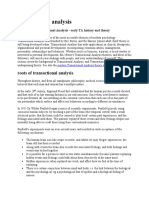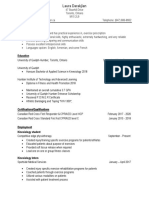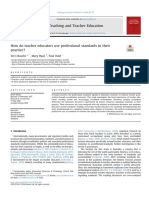Starting
Starting
Uploaded by
Muhammad Yusuf PilliangOriginal Description:
Copyright
Available Formats
Share this document
Did you find this document useful?
Is this content inappropriate?
Report this DocumentCopyright:
Available Formats
Starting
Starting
Uploaded by
Muhammad Yusuf PilliangCopyright:
Available Formats
Starting the Writing Process
Starting an application essay is perhaps the hardest point in the entire process. Few people write about themselves with great confidence. Some students miss the opportunity to benefit from a fellowship application or even from graduate school because they never get over the initial reluctance to start the essay. Where do you begin? Start before you are ready. Think about the questions in Making Connections. Ask yourself, who am I, and who do I want to be? Create a folder for random notes for your personal statement or application essay. Be ready to jot down ideas at any time. Make an inventory of everything you have done as an undergraduate. Selected parts of this inventory will be featured in the essay eventually, but try to be inclusive at first. Try scheduling short appointments with yourself to generate ideas and to write. These could be for 30 minutes, or an hour, several days a week. If you can make it to practice, rehearsal, meetings, classes, or work, then you can schedule these short blocks of time for yourself, just to reflect and to write. Avoid binges in which you attempt to write a polished essay at one sitting before a deadline or meeting with an advisor. Allow yourself enough time to go through the entire process of writing and revision. After re-reading the essay prompts and the Definition of a Personal Statement, consider these techniques for generating, organizing, and drafting the essay. Generating Content To start, try to generate ideas and simply get things down on paper. Many people find it helps to try brainstorming, free writing, or clustering: 1) Brainstorming: Brainstorming means coming up with ideas of how to approach a topic. Set a time limit and write down in list form every word or phrase that comes to you about the essay topic. Make a list of things you have done or aspects of your topic. When you are finished, look over the list and look for patterns, clusters of interesting ideas, or one central idea. 2) Free writing: Once you have some ideas, set a time limit and write about each one without stopping. When the time is up, look at what you have written. Look over your writing and determine which idea seems most significant. Much of your writing will be irrelevant or even nonsensical, but you may find important insights and ideas with which to work. 3) Clustering: Clustering is a way to generate ideas using a visual scheme or chart. It is useful for understanding the relationships among the parts of a broad topic and for developing sub-topics. Write down your topic in the middle of a blank piece of paper and circle it. In a ring around the topic circle, write down what you see as the main parts of the topic and circle each one. In a ring around the main parts, write down examples, facts or details. 1
Keep clustering until you list everything you want to say. Clustering should enable you to tell if you need to do more research on your topic.
Organizing Material As you come up with information for your essay, you will need to think about how to organize it. The most efficient way to organize your ideas is through a series of outlines. Once you know the basic content of your essay, write a list of the main points you want to make. Organize the list. Try to make each point flow from the previous point and link to the next point. Sometimes, an abrupt transition may be appropriate. When you have an organized list of main points, fill in the supporting information for each one. Once you have a general sense of the organization that the essay will follow, write a detailed formal outline. A formal outline will allow you to see exactly how the parts of the essay fit together. Also, you will be able to tell if you need to do more research for a particular point. Drafting the Essay After you develop an outline, write a rough draft of the essay. If you get stuck, make a new outline. When you have written a draft, put it away for a few days and then review it again. Leave yourself plenty of time to revise and edit. Revising: Revising and editing are not the same. Revision means literally to look again at something. Take a fresh look at the organization of your points, how well they are developed, and how persuasive the essay is. Ask yourself questions like these: Do I clearly express myself? Does the essay convey my purpose? Do I take a stance on the issue I am addressing? Is the essay appropriate for an audience of application evaluators? Be willing to experiment with completely different versions. You will know when a paragraph or section begins to gel. Editing: Once you have revised your essay, edit it. Editing entails fine-tuning your prose and checking your grammar, punctuation, tone, spelling and formatting. Get an Outside Opinion Once you have revised and edited your essay, you may be too tired of it to evaluate its effectiveness. At this point, it is a good idea to have other people read over the essay. Ask at least one a peer (a friend or a tutor at the writing center) and one expert in your field to respond to it. You may want to ask an academic advisor, professor, work supervisor, or scholarship advisor. Remember that asking someone to read your essay is a favor. If someone agrees to read it, he or she will appreciate it if the essay is as polished as you can make it. Be prepared to revise the essay again based on the feedback that you receive. If you get stuck at an earlier stage in the process, talk to other people. Outside opinions can help at any time.
You might also like
- Currie, Gregory - Image and Mind PDFDocument329 pagesCurrie, Gregory - Image and Mind PDFAlejandra QuinteroNo ratings yet
- Aberth Black DeathDocument12 pagesAberth Black Deathisiswang1110% (6)
- MBTI Types and Executive Coaching 2006Document9 pagesMBTI Types and Executive Coaching 2006Nilesh WarNo ratings yet
- Writing Rough Draft of Research PaperDocument1 pageWriting Rough Draft of Research PaperRaja AdilNo ratings yet
- SAM TheHumanMindDocument9 pagesSAM TheHumanMindshishir_thakur2005No ratings yet
- Sociology of SelfDocument10 pagesSociology of SelfEghweree Ogheneruonah CharlesNo ratings yet
- Still Believe in The MBTI Personality Type Theory? Think AgainDocument3 pagesStill Believe in The MBTI Personality Type Theory? Think AgainJennifer WilsonNo ratings yet
- A Dialogue of Unconsciouses PDFDocument10 pagesA Dialogue of Unconsciouses PDFIosifIonelNo ratings yet
- Roots of Transactional AnalysisDocument6 pagesRoots of Transactional Analysispranav raoNo ratings yet
- The Relationship Between The Big Five Personality Traits and Academic MotivationDocument11 pagesThe Relationship Between The Big Five Personality Traits and Academic Motivationparadiseseeker35No ratings yet
- Ecofeminism Thoughts: The Effective Analysis Based On Mother ArchetypeDocument6 pagesEcofeminism Thoughts: The Effective Analysis Based On Mother ArchetypereviewjreNo ratings yet
- Toward A New Approach To The Sutyd of Personality in CultureDocument11 pagesToward A New Approach To The Sutyd of Personality in Culturewyh1919100% (1)
- Angelina Bennet PDFDocument23 pagesAngelina Bennet PDFsddsppNo ratings yet
- The Trait Approach To Personality Is One of The Major Theoretical Areas in The Study of PersonalityDocument17 pagesThe Trait Approach To Personality Is One of The Major Theoretical Areas in The Study of PersonalityClaire RoxasNo ratings yet
- Stress Management For Every Type: Carol Sommerfield, PH.D., PMP, SPHR, GCDFDocument26 pagesStress Management For Every Type: Carol Sommerfield, PH.D., PMP, SPHR, GCDFsddsppNo ratings yet
- Sufism in The West: Ron GeavesDocument24 pagesSufism in The West: Ron GeavessomeoneNo ratings yet
- Andragogy and PedagogyDocument3 pagesAndragogy and PedagogyaldyerNo ratings yet
- What Do We Know When We Know A PersonDocument33 pagesWhat Do We Know When We Know A PersonHyun Jin ChunNo ratings yet
- Druce - Animals in English Wood CarvingsDocument28 pagesDruce - Animals in English Wood Carvingsmdreadinc2No ratings yet
- Do What You Are Handbook 2008Document23 pagesDo What You Are Handbook 2008q12345q6789No ratings yet
- Ernest Kurtz - Bill W. Takes LSD - 1Document13 pagesErnest Kurtz - Bill W. Takes LSD - 1Carey PickardNo ratings yet
- 43 PF 10 PosterpdfDocument1 page43 PF 10 PosterpdfAdam HillNo ratings yet
- How To Prepare and Deliver A Speech Effectively: Stikes NU Tuban 2020Document3 pagesHow To Prepare and Deliver A Speech Effectively: Stikes NU Tuban 2020Hanatasya Ridha DeaniraNo ratings yet
- Ah, I See! Metaphorical Thinking and The Pleasure of Re-CognitionDocument25 pagesAh, I See! Metaphorical Thinking and The Pleasure of Re-CognitionEduardo Souza100% (1)
- A Symbol For Transcendence - The Human Figure in The Visual ArtsDocument125 pagesA Symbol For Transcendence - The Human Figure in The Visual ArtsNeaga Roberta CristinaNo ratings yet
- 4 Qs MBTIDocument3 pages4 Qs MBTIrv5No ratings yet
- Interpersonal AttractionDocument60 pagesInterpersonal AttractionSamit RajanNo ratings yet
- Applications of Andragogy in Multi-Disciplined Teaching and Learning PDFDocument11 pagesApplications of Andragogy in Multi-Disciplined Teaching and Learning PDFtigresse123No ratings yet
- Reinterpreting The Myers-Briggs Type IndicatorDocument25 pagesReinterpreting The Myers-Briggs Type IndicatorManuel DíazNo ratings yet
- Detection of Myers-Briggs Type Indicator Via Text Based Computer-Mediated CommunicationDocument4 pagesDetection of Myers-Briggs Type Indicator Via Text Based Computer-Mediated CommunicationanilaisuigresNo ratings yet
- NSDC CoachingDocument4 pagesNSDC CoachingirdhinNo ratings yet
- Article Writing Templates & Writing Style Guidelines: Copy FlowDocument5 pagesArticle Writing Templates & Writing Style Guidelines: Copy FlowHisham MohammedNo ratings yet
- Myers Briggs ActivityDocument5 pagesMyers Briggs ActivitywhitepaladinNo ratings yet
- Imaginal Exercises PDFDocument4 pagesImaginal Exercises PDFSonali FoxNo ratings yet
- Power of ClayDocument7 pagesPower of ClaySahu RaNo ratings yet
- Space As A Semantic Unit of A Language ConsciousnessDocument16 pagesSpace As A Semantic Unit of A Language ConsciousnessEve AthanasekouNo ratings yet
- Teaching Meyerhold: July 2016Document8 pagesTeaching Meyerhold: July 2016whookersNo ratings yet
- Creativity As A Sociocultural ActDocument16 pagesCreativity As A Sociocultural ActLou VreNo ratings yet
- Introducing Social PsychologyDocument10 pagesIntroducing Social Psychologydevyani rathodNo ratings yet
- Five Factors of PersonalityDocument12 pagesFive Factors of PersonalityCristina M. PascariNo ratings yet
- Breakthrougher I (Surpass Your Aspirations)Document150 pagesBreakthrougher I (Surpass Your Aspirations)Amit ModaniNo ratings yet
- Rosemarie Anderson - Intuitive Inquiry: Interpreting Objective and Subjective DataDocument17 pagesRosemarie Anderson - Intuitive Inquiry: Interpreting Objective and Subjective DataFlikk34100% (1)
- Obscurity in Medieval TextsDocument204 pagesObscurity in Medieval TextsMarthaNo ratings yet
- The Life and Soul of The ImageDocument9 pagesThe Life and Soul of The ImagePandoraCreaNo ratings yet
- The Animate and The Inanimate - William James SidisDocument88 pagesThe Animate and The Inanimate - William James SidisAdriano CordeiroNo ratings yet
- Personality Theory PaperDocument6 pagesPersonality Theory PaperSundra Flash Fab BlingNo ratings yet
- Relationship Between MBTI and Career Success - Yu 2011Document6 pagesRelationship Between MBTI and Career Success - Yu 2011alanwilNo ratings yet
- NSTP Module 3.2Document21 pagesNSTP Module 3.2Lannie GarinNo ratings yet
- The War of Art PDFDocument1 pageThe War of Art PDFethanNo ratings yet
- Positive PsychologyDocument51 pagesPositive PsychologyirrianadazNo ratings yet
- Thought PlaceDocument128 pagesThought PlaceMennatallah M.Salah El DinNo ratings yet
- The Self and UpanishadsDocument3 pagesThe Self and UpanishadsPratyusha KameswarNo ratings yet
- Self AwarenessDocument36 pagesSelf AwarenessAnkur BhuvanNo ratings yet
- Using Francis Bacons Idols To Foster Cri PDFDocument3 pagesUsing Francis Bacons Idols To Foster Cri PDFCarl SerranoNo ratings yet
- Overcoming Fear of FailureDocument2 pagesOvercoming Fear of FailureKaka AuliyaNo ratings yet
- Measuring Creativity From The Child's Point of View: Mary MeekerDocument11 pagesMeasuring Creativity From The Child's Point of View: Mary Meekersazzad hossainNo ratings yet
- 2007 Pfaffenberger - Eploring Pathways To Postconventional Ego DevelopmentDocument159 pages2007 Pfaffenberger - Eploring Pathways To Postconventional Ego DevelopmentAnssi BalkNo ratings yet
- Equipped to Bless: Finding Relevance in the Stories of Your LifeFrom EverandEquipped to Bless: Finding Relevance in the Stories of Your LifeNo ratings yet
- National Commission On Indigenous People-Engineer IiDocument1 pageNational Commission On Indigenous People-Engineer IiHerschell Vergel De DiosNo ratings yet
- Janine Moore Teacher ResumeDocument2 pagesJanine Moore Teacher Resumeapi-457040901No ratings yet
- Critical Voices in EducationDocument304 pagesCritical Voices in EducationLevi Miller100% (1)
- Differentiatedlesson Rbrady For PortfolioDocument9 pagesDifferentiatedlesson Rbrady For Portfolioapi-378198603No ratings yet
- DISC Form PDFDocument10 pagesDISC Form PDFcorneliuskoo100% (1)
- BSP/GSP Action Plan S.Y 2019-2020: 1. Acquire Knowledge and Related Skills Regarding BSP/GSP ActivitiesDocument1 pageBSP/GSP Action Plan S.Y 2019-2020: 1. Acquire Knowledge and Related Skills Regarding BSP/GSP ActivitiesLaira Joy Salvador - ViernesNo ratings yet
- Preparing Ozone Test Strips (Aka Schoenbein Papers)Document7 pagesPreparing Ozone Test Strips (Aka Schoenbein Papers)Old McDonaldNo ratings yet
- Lapoescott ResumeDocument1 pageLapoescott Resumeapi-356356986No ratings yet
- Applied Malacology: A Different Approach To Teaching A Traditional TopicDocument16 pagesApplied Malacology: A Different Approach To Teaching A Traditional TopicGustavo DarrigranNo ratings yet
- Bonga Nhs - Shs Proposed f2f ScheduleDocument12 pagesBonga Nhs - Shs Proposed f2f ScheduleJames Albert S. PoleroNo ratings yet
- Criterion Reference Vs Norm Referenced TestingDocument1 pageCriterion Reference Vs Norm Referenced TestingXlian Myzter Yosa100% (3)
- Bail 2020Document7 pagesBail 2020marisaNo ratings yet
- Resume JacobDocument2 pagesResume Jacobapi-382001811No ratings yet
- MHPS Personnel Report 2.15.24Document4 pagesMHPS Personnel Report 2.15.24heatherlinkNo ratings yet
- Teaching and Learning in A Digital WorldDocument424 pagesTeaching and Learning in A Digital Worldcatalinlungeanu758100% (2)
- Department of Education: de La Paz Elementary School List of Teaching and Non-Teaching PersonnelDocument2 pagesDepartment of Education: de La Paz Elementary School List of Teaching and Non-Teaching PersonnelKent Russel MillenaNo ratings yet
- The Complete Guide To IeltsDocument19 pagesThe Complete Guide To IeltsHà Phương100% (1)
- Ubd - Energy Conservation and TransformationDocument2 pagesUbd - Energy Conservation and Transformationapi-386385143No ratings yet
- Adjective ModifierDocument3 pagesAdjective ModifierHara DoNo ratings yet
- Answers Module 12Document2 pagesAnswers Module 12Deib EnrileNo ratings yet
- Teaching and Teacher Education: Terri Bourke, Mary Ryan, Paul OuldDocument10 pagesTeaching and Teacher Education: Terri Bourke, Mary Ryan, Paul OuldmnurtantoNo ratings yet
- Internship DiaryDocument9 pagesInternship DiaryS VasanthNo ratings yet
- Assessing Listening (Macro & Micro Skills) (Types of Assessment Methods)Document15 pagesAssessing Listening (Macro & Micro Skills) (Types of Assessment Methods)Aisyah MusfirahNo ratings yet
- VSO Activity Book PDFDocument127 pagesVSO Activity Book PDFVictorNo ratings yet
- Systems Prevention of Youth HomelessnessDocument36 pagesSystems Prevention of Youth HomelessnessAudra WilliamsNo ratings yet
- Report E-Week NewDocument6 pagesReport E-Week NewFauzan MananNo ratings yet
- Sec Filipino 0312Document29 pagesSec Filipino 0312NonoyTaclinoNo ratings yet
- G3 Selective LessonPlan Unit4Document20 pagesG3 Selective LessonPlan Unit4binh lanh toNo ratings yet
- Educ 106 - First Act. LarryJr.D.guimbardaDocument8 pagesEduc 106 - First Act. LarryJr.D.guimbardaLarry GuimbardaNo ratings yet
- TOS 4th QUARTERDocument2 pagesTOS 4th QUARTERAljerr LaxamanaNo ratings yet

























































































